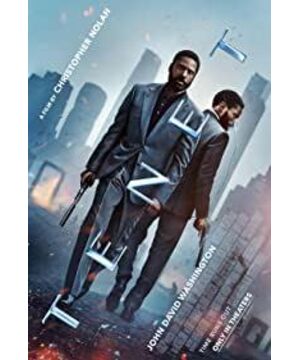In 1961, the American short story sci-fi ghost Frederick Brown published a novel. The full text has only 8 lines, but it is shocking:
end
(United States) Frederick Brown
Professor Jones has been studying time for many years.
"I finally invented a machine," he said to his daughter, "it can take us back in time."
He pressed the button on the machine and said:
"The machine can make time go back."
". When walking back to the room, let the energy machine"
: Say yes, the upper device of the button button presses him next
"I have been to the back, I will take it ", say the children to him", the machine will be sent to me as soon as I know it."
. In Zhiyi, I have been teaching Sjoan for more than the next year.
Rambe Criedley (United States)
End of day
This novel presents reverse time wonderfully in plain text.
It is the core plot of "Creed".
Stripping off the "brain-burning" coat, the story is actually very simple:
In the future, mankind invented the technology of reversing time. They send this technology back to the present, hoping that the world will be ruined in a positive and an anti-collision. The protagonist is ordered to stop the disaster with his partner Neil. In one line, it is: "We are fighting against the future."
The movie was 150 minutes, the first 75 minutes was an ordinary spy movie, and the last 75 minutes began to embark on a way back, retracing the past. Brown only wrote 8 lines, and Nolan took this feeling for an hour.
How did you do it?
This article attempts to point out the time reversal mechanism of "Creed" and how it participates in the film narrative.
01 Time Reverse and Time Reversal
First of all, we must admit that in most sci-fi works on such themes, as well as our daily experience, "back in time" is like this:
In a time travel, the character jumps back or forward to a certain point in time, such as 1900, and the audience follows them along.
At this time, everything around still obeys the basic rules of physics. For example, back in 1900, the sun was still rising in the east and setting in the west, people were still walking forward, and things still happened because of the first cause and consequence (except for the grandfather's paradox).
However, the reverse of time in "Creed" is completely different: it reverses all events and actions. Walking backwards, talking backwards, everything has results first, and then causes.
At this time, calling "time reverse" will cause wrong associations. Strictly speaking, it should be called "time reverse" . The term time reversal comes from quantum mechanics. The full name of the original term is "T-symmetry or time reversal symmetry" , which means that the space coordinate is unchanged and the time coordinate is reversed.
In the daily experience of human beings, the past and the future are different, the cause and the effect are different, and they cannot be exchanged with each other. The bullet was shot out, and the water fell from a high place. If it came upside down, it would look ridiculous.
But in physics, the basic laws of physics will show no difference between the past and the future. Although bullets flying back to the muzzle seem absurd, if you enter the microscopic level and stare at the particles in it, you will find that they are highly consistent with the laws of physics. There is a classic example: if you shoot a ball that is falling, there is no difference between playing the video forward and backward. The physical principles involved in the two are exactly the same. In other words, for the basic laws of physics, it makes no difference whether time goes forward or backward.
"Creed" also reproduced this experiment. The protagonist saw the reverse weapon for the first time in scientist Laura's laboratory. He made the act of discarding it before the bullet flew back to his hand. It was recorded that there was no difference between the two processes.
Then, why do we feel that the first action is reversed?
Because we give meaning to the starting point,
In other words, setting the direction for time,
In other words, the law of causality.
We believe that only from the front to the back is correct, the front is the cause and the back is the effect.
Time reversal is a more complicated and interesting concept than time reversal, because it provokes our daily experience . The so-called positive and negative, cause, and effect are just subjective "illusions".
Before the birth of physics, people have discovered this phenomenon in daily life-some things are the same. The palindrome of Sato in ancient Rome, the title of "Creed" and the names of key characters and locations in the film came from this.
SATOR
AREPO
TENET
OPERA
ROTAS common explanation: a person named Arepo plows the land with a hoe
It is also rumored that Napoleon said when he was exiled:
Able was I ere I saw Elba
Lost in the lonely island
Later, it became a form of rhetoric in literature: palindrome.
Literary masters have also used novels to depict inversion:
"The End" by Frederick Brown
Philip K. Dick's "Counterclockwise World"
"Time" by Brian Aldis
"Holy Madness" by Roger Zelazny
FS Fitzgerald's "The Curious Case of Benjamin Button"
"Time Clash" by Barrington J. Bailey
"Collapse" by Liu Cixin...
If it is ordinary time travel, Professor Jones presses a button and goes back to the age of 3, which is far less shocking than inversion. However, the visualization of time reversal is a threshold. After filming into a film and television series, it can only be done partially. For example, "The Curious Case of Benjamin Button", the reversal only takes place on the physical level of the protagonist.
The visual presentation of time reversal on the big screen is too difficult. "Creed" is such a hard bone.
02 Maxwell Demon
The dead rationalists are asking: Is time reversal actually possible? Is there any theoretical support?
This involves the second concept, entropy.
Our daily experience shows that in the macro world, time reversal symmetry is not applicable.
The most famous example is the second law of thermodynamics .
The second law of thermodynamics says (Clausius' expression): Heat cannot be transferred spontaneously from a low-temperature object to a high-temperature object.
Many phenomena, such as friction between objects and viscous motion of fluids, can be explained by the second law of thermodynamics, because useful energy (such as kinetic energy) will be lost to heat energy over time.
In time reversal, the physical laws that act on each particle remain unchanged, but the thermal energy will still only be lost, which becomes an eternal variable.
Is the loss of heat energy really irreversible? Many physicists have thought about this problem, such as Maxwell.
He proposed a thought experiment. In the experiment, a closed space is divided into two parts. There is a monster on the critical surface, which brings the slow molecules to one side, and the fast molecules to the other side, making an area more and more. The colder, the hotter the other area, so it seems that it can lead to a decrease in entropy, thereby reversing the direction of time-this is the Maxwell demon .
Time reversal symmetry and Maxwell's demon , are fascinating concept.
Although they are generally feasible in theory and cannot be 100% scientifically established, artists can use their imagination. In 1958, William Morrison's " Joseph Samachson, A Feast of Demons " (Joseph Samachson, A Feast of Demons), based on Maxwell’s demon, envisioned a demon that could manipulate the increase and decrease of entropy . This demon can reverse aging and accelerate aging. From the perspective of daily experience, it is that human time has been reversed.
The "Maxwell Demon" in "Creed" can be seen as future people who have mastered entropy reduction technology, or as a revolving door they made to flexibly change the flow of entropy of people or objects.
Nolan stated that he asked Kip Thorne to read the script to ensure that most of the settings are scientific: "Although scientifically, the reversal of entropy is not equal to the reversal of time, but in theory, if you can Reverse the entropy of an object, then you can also reverse the time of the object, so this story is still based on physics."
Entropy reduction = time inversion
This hypothetical equation roughly lays the foundation of the film's worldview.
Why is the entropy reversed in reverse time, but the laws of physics are not invalidated? The world didn't fall apart? Humans still exist?
Because according to the symmetry of time reversal, the laws of physics have not changed (counter-examples such as the second law of thermodynamics are ignored under the setting).
But at the macro level, people can feel the difference, so when the protagonist enters the revolving door, he gets a series of warnings:
"At first, you will feel weird. You have to get used to it for a while. If you run forward, the wind will blow from behind, and the friction and resistance will be opposite. The heat of the fire will freeze on the skin, because the opposite of heating is Cool down. Gravity is temporarily normal, but it seems to be opposite around you."
03Use time as a weapon
After clarifying the big setting, we can see how it participates in the narrative.
If in "Interstellar", time is an impenetrable wall, in "Deadly Magic", time is a diary that turns over and over again, in "Creed", time is a weapon of mass destruction.
On the one hand, people in the future will use time to destroy the world.
-Annihilation Annihilation: When matter meets its antimatter, a complete matter-energy conversion and conversion into energy will occur. It is also called mutual destruction and cancellation. The future man invented an algorithm, not for people or things, but It is a reverse attack on the entire world . The law of nature determines the positive flow of time. When the law is changed and the forward and reverse collide, it is game over. The theoretical basis is that when the positive and anti-particles meet, annihilation will occur.
-Reverse weapons. People in the future will also reverse the entropy of general weapons and send them back to modern times. Reverse weapons can cause huge damage. The heroine Kat was hit by a reverse bullet. During the military action at the end of the film, the soldiers were also blown up by reverse bombs (recovered) and sealed in the wall.
On the one hand, the protagonist also uses time to contain the enemy.
-Time pincer movement or pincer movement, military term, refers to pinching the enemy from both sides, forcing the enemy to lengthen the front; time pincer movement, as the name implies, is a pincer offensive in time
In order to capture the algorithm of reverse strike, the protagonist participated in a military operation. The two teams set off at the same time, one group is forward and the other is reverse. The forward group takes action based on the "results" experienced by the reverse group.
Finally, the time pincer movement not only appeared in this mission, but also throughout the film.
When time becomes a weapon, this kind of large-scale attack using the laws of basic physics is a bit like the dimensional warfare in "Three-Body", and even has the meaning of a weapon of God-level civilization.
However, the rules and paradoxes are also very obvious:
-Red and blue
Nolan uses red and blue as the positive and negative signs. In the film, the hint of this color is always lurking. On both sides of the inspection window, red light is forward and blue is reverse. In military operations, red is the forward group and blue is the reverse group.
It is easy to think of some basic concepts, entropy increase & entropy decrease, high temperature & low temperature, red shift & blue shift...
In Da Liu's "Collapse", the redshift of the universe begins to blue shift after reaching a singularity, triggering a time reversal.
"Just tell me what will happen when it collapses or when the blue shift of the universe begins?" the governor asked anxiously. "Time will reverse." Ding Yi replied. "...Inversion?" The governor looked at the head of the station in confusion, then at Ding Yi. "Go back in time." The director explained briefly.
-The grandfather's paradox An obvious contradiction is: If the future man destroys the present, wouldn't it mean killing the ancestors?
There is no explanation in the film, and Neil just gave a guess: they don't care.
It can be understood that the future people just want to die together, or they just killed the ancestors in the parallel world, or they did not completely kill the ancestors, and the people who lived to the end became the future people (this is another fine Thinking of terrifying brain hole).
-The past cannot be changed. As scientist Laura said at the beginning, you can catch a bullet because it has been caught by you. The subtext is exactly the consistent view of Nolan's works: the past cannot be traced.
In the film, the protagonist wants to go back to the past through entropy reduction several times and change the outcome of things, but Neil stops him, including the regrettable farewell: Neil knows he is going to die.
"Will a change of choice change the outcome?" "Happened is what happened. This is the belief required for the normal functioning of the world, not an excuse for us to escape." "This is fate?" "It is reality."
This may be the most flawed movie we have ever seen.
The most obvious one is: if everything is destined to happen and cannot be changed, then this doomsday crisis will not exist at the beginning.
But these flaws are very great.
Because it challenges something that no one would want to do, not even what a commercial film should do.
Nolan did three things:
The first is to break through the general time travel movies. Revolutionary innovations have been made to the visual performance of "back in time".
The second is to break through ordinary spy films. Apply the concept of time reversal to specific people and things. The conversation at the end reveals everything: this is a story of "my starting point" and "your end" intertwined. It is the protagonist who dominates this action in the future, hires Neil as his subordinate, and launches a time pincer offensive against the enemy, forming a palindrome doll: (clamp (clamp (clamp 1) shape 2) shape 3) Although full Loopholes, but do not affect the integrity of the story. Nolan's ambition is not to design a difficult setting, but to use it in the spy film system, and even make the entire subject matter serve the spectacle itself.
The third is to subvert the audience's perception. Inverting the law of cause and effect on the big screen, no matter how subtle the idea itself, it will surely shatter daily experience in terms of perception. Nolan knew this well.
The science fiction critic Rabbit Kuai believes: " In addition to challenging the basic laws of narrative literature and commercial works, he is also challenging the brain habits of the audience. No one dares to do this, and no one wants to do it, only words that have reached the status of Nolan. Power, creativity, and execution can only be achieved. But it successfully allows you to see the end, leaving behind a lot of uncomfortable things. The value of this film lies in making the audience think, Why do I feel uncomfortable? "
Challenges daily experience is a kind of courage, but also touches the essence of science fiction——
Give up anthropocentrism. On the scale of the universe, the laws and common sense we think may be worthless.
"You will discover how reasonable it is to go from old age to infancy, from mature to naive, and how natural it is. If someone talks about another direction of time, you will think that he is idiotic and dreamy."-Liu Cixin, "Collapse"
※ Finally, I will emphasize the viewing method. After watching the film, we all agreed that BGM should use Canon. Canon is a kind of polyphonic music, which repeats with a melody staggered several times in different parts, and reciprocates continuously.
Usually, listening to Canon, you will not think about the respective progress and relative positions of melody a, melody a1, and melody a2, but will appreciate the beauty of melody as a whole.
Although we often say that polyphonic music is mathematical, the meaning of its existence is not to do arithmetic, but to appreciate art. This is like the "creed".
You will instinctively carry out logical analysis and think about the corresponding relationship between positive and negative time, but if you let your instinct go, you will miss a lot of things.
Appreciating the interlacing of the "melody" of time is the core of all Nolan's works.
Just like, in "Inception", waiting for layers of dreams to wake up in sequence.
In "Dunkirk", the three lines of land, sea and air overlap each other.
In "Interstellar", the young father holds his daughter's wrinkled hand.
I wish you a pleasant viewing of "Creed". On the next Authority
After reading, please talk to us if you have the feeling of losing face on the timeline
View more about Tenet reviews











